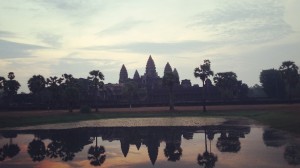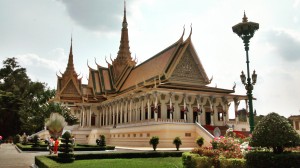Par André Capretti
Je trouve ça difficile à croire que ça fait juste deux semaines que je suis au Cambodge. Avec toute l’action qu’il y a en ce moment au pays j’ai l’impression d’avoir passé des mois ici !
Depuis que je suis ici je n’ai pas besoin de mettre de réveil les matins. La chaleur est tellement intense que je me réveille tout seul peu après que le soleil se soit levé. À Montréal je ne suis pas matinal du tout, mais ici à Phnom Penh j’ai dû développer une nouvelle routine pour m’habituer au climat. On me dit que la période sèche vient de se terminer, et que maintenant c’est la saison de pluie qui commence. Je ne peux pas imaginer comment il pourrait faire plus chaud qu’il fait ces jours-ci. Déjà le mercure a frôlé le 50 degrés Celsius à plusieurs reprises, et la température moyenne varie de 35 à 40 degrés, 45 avec l’humidité. C’est une chaleur que je qualifierais de suffocante ou d’étouffante. En conséquence je dois ralentir mon rythme de vie, boire autant d’eau que possible pour étancher ma soif, et m’enduire de crème solaire (SPF 80!) à chaque sortie.
Pendant que moi j’ai du mal à endurer cette canicule constante, je constate que les gens du Cambodge, qu’on appelle aussi les Khmers, ne semblent pas autant perturbés par la chaleur. J’ai du mal à m’imaginer comment ils peuvent supporter cette température lorsque la grande majorité d’entre eux portent seulement des pantalons et des chandails à manches longues. Un collègue cambodgien me dit que pour lui, ce qui est plus impressionnant c’est le fait qu’au Canada on puisse supporter des hivers glaciaux ! La comparaison est apte. Dans les deux cas on n’a qu’à changer notre mode de vie un peu pour s’adapter. On sort moins, on réduit nos activités et lorsqu’on sort on a hâte de retourner à un abri intérieur, soit pour l’air climatisé, soit pour le chauffage. Et donc finalement nos luttes quotidiennes contre le climat ne sont pas si différentes que ça !


*****************
While I may be able to relate with the weather-related struggles faced by Cambodians, there is a different, far more important source of oppression that Cambodians face on a daily basis which is harder to relate with. It’s the reason why I’m here.
Every morning I hop on the back of a motodop (basically a motorcycle-taxi) and make my way to work. While my motorcycle driver darts and weaves through the crazy traffic-filled streets of Phnom Penh, I always try and take in the surrounding sights: merchants selling their wares, families of 3, 4 (or even 5!) on the back of a single motorbike, food stalls with vendors selling coffee, spring rolls, or a variety of hearty meat dishes, smiling kids making their way to school, street dogs ambling about, tuk-tuks full of foreigners (tourists or “ex-pats”). The list goes on. Once I arrive at LICADHO, I’m greeted by calls of suesdai (“hello” in Khmer) from the local staffers, and a refreshing blast of cool air from the air-conditioning, which provides a welcome respite from the extreme heat outdoors.
While the “oppressive” Cambodian heat may cause me some temporary discomfort, it is nothing compared to the real problems and human rights abuses faced by so many Cambodians. The stifling temperatures here go hand in hand with a political climate in which dissent is stifled at every turn.
My first few work assignments at LICADHO have been related to a recent political scandal involving Kem Sokha, the acting leader of the opposition party, the CNRP. At first glance the case appears to be a run-of-the-mill sex scandal involving a respected politician. However, on further inspection the case is far from ordinary. The case has snowballed and taken on many tangents, entangling other opposition party politicians, respected human rights advocates and NGO officials, prominent elections officials, a political analyst, a social media celebrity, and even a UN employee.
LICADHO itself has been caught in the fray on two occasions. Once on May 9th, when three of its staffers were arrested (later released) while trying to protest the unjustified detention of five human rights defenders, who were arrested on highly questionable charges. The demonstration was part of a campaign that has been coined #BlackMonday, in which the public is called on to wear black every Monday, and protest against the group’s detention. This popular movement has triggered paranoia in the government, as they have labeled these peaceful protests an “act of rebellion” and an attempt to start a “colour revolution” (a term that refers to non-violent protest movements which led to regime change in many Eastern European countries in the early 2000s).
The second incident occurred after the Ministry of Justice threatened LICADHO for having published a list on its website of 29 political prisoners currently being detained or jailed in Cambodia on politically motivated charges.
It is widely alleged and believed that the ruling party, the CPP, has manufactured the whole legal conundrum enveloping the Kem Sokha affair in order to undermine the opposition party in anticipation of regional elections in 2017 and national elections in 2018. The current government has a track record of using the judicial system to crack down on political opposition, civil society and human rights groups. As noted by UN Envoy Rhona Smith, the Cambodian government appears far too comfortable abusing the rule of law to accomplish their political goals: “There is certainly concern of the use of law as a political tool rather than a legal tool for securing justice”.
There is so much going on here at the moment related to human rights abuses, that I find myself a bit overwhelmed by the sheer magnitude of issues. That being said, I am reassured by the amazing work being done by organizations like LICADHO, and by the indomitable spirit of the Cambodian people, who are fighting for a long list of causes, including among others, freedom of speech, freedom of assembly, labour rights, and land rights. My time here has only added to the admiration that I have for the sacrifices that LICADHO and other Cambodian rights groups and grassroots activists are willing to make in the name of civil resistance and human rights advocacy.
For more information about LICADHO, check out their website – http://www.licadho-cambodia.org/ – & Facebook page – https://www.facebook.com/licadho/?fref=ts
